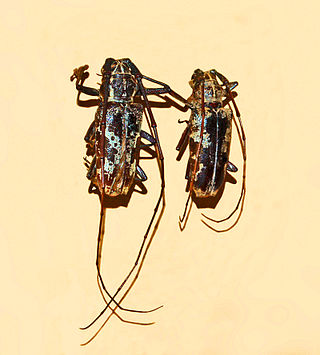
Ficus is a genus of about 850 species of woody trees, shrubs, vines, epiphytes and hemiepiphytes in the family Moraceae. Collectively known as fig trees or figs, they are native throughout the tropics with a few species extending into the semi-warm temperate zone. The common fig (F. carica) is a temperate species native to southwest Asia and the Mediterranean region, which has been widely cultivated from ancient times for its fruit, also referred to as figs. The fruit of most other species are also edible though they are usually of only local economic importance or eaten as bushfood. However, they are extremely important food resources for wildlife. Figs are also of considerable cultural importance throughout the tropics, both as objects of worship and for their many practical uses.

Ficus religiosa or sacred fig is a species of fig native to the Indian subcontinent and Indochina that belongs to Moraceae, the fig or mulberry family. It is also known as the King Tree (Arasa Maram) (in Tamil), bodhi tree, peepul tree, peepal tree, pipala tree or ashvattha tree (in India and Nepal). The sacred fig is considered to have a religious significance in three major religions that originated on the Indian subcontinent, Hinduism, Buddhism and Jainism. Hindu and Jain ascetics consider the species to be sacred and often meditate under it. Gautama Buddha is believed to have attained enlightenment under a tree of this species. The sacred fig is the state tree of the Indian states of Odisha, Bihar and Haryana.

Clytus is a genus of longhorn beetles in the family Cerambycidae.

The Cassidinae are a subfamily of the leaf beetles, or Chrysomelidae. The antennae arise close to each other and some members have the pronotal and elytral edges extended to the side and covering the legs so as to give them the common name of tortoise beetles. Some members, such as in the tribe Hispini, are notable for the spiny outgrowths to the pronotum and elytra.

Erotylidae, or the pleasing fungus beetles, is a family of beetles belonging to Cucujoidea containing over 100 genera. In the present circumscription, it contains 6 tribes and 10 subfamilies. In other words, the narrowly circumscribed Erotylidae correspond to the subfamily Erotylinae in the definition sensu lato. There are doubts on the monophyly of lower ranked taxa within Erotylidae, with further phylogenetic studies requiring better sampling and studies of unexplored character sets, for example the metendosternite and penile flagellum, which are generally lacking detailed morphological studies within the Coleoptera literature. The Eroytlina taxonomy is based on traits such as their different colors and not off morphological differences like mouthparts, thorax, and abdominal terminalia (Pecci-Maddalena).

Agrilus is a genus of jewel beetles, notable for having the largest number of species of any single genus in the animal kingdom.

Ficus gracilis is a species of sea snail, a marine gastropod mollusk in the family Ficidae, the fig shells.
Dismorpha is a genus of beetles in the family Buprestidae, containing the following species:

Actenodes is a genus of beetles in the family Buprestidae, containing the following species:

Chalcolepidius is a genus of beetles in the family Elateridae.

Epepeotes desertus is a species of flat-faced longhorns beetle belonging to the family Cerambycidae, subfamily Lamiinae.

Epepeotes is a genus of flat-faced longhorns beetle belonging to the family Cerambycidae, subfamily Lamiinae.

Clytini is a tribe of beetles in the subfamily Cerambycinae, containing the following genera:

Neoclytus is a genus of beetles in the family Cerambycidae. They measure 4-20 mm. There are 93 species in the New World.

Elaphidion is a genus of beetles in the family Cerambycidae, containing the following species:

Lamiini is a tribe of longhorn beetles of the subfamily Lamiinae.
Epepeotes vestigialis is a species of beetle in the family Cerambycidae. It was described by Francis Polkinghorne Pascoe in 1866.

Epepeotes luscus is a species of beetle in the family Cerambycidae. It was described by Johan Christian Fabricius in 1787. It is known from Malaysia, China, Indonesia, Cambodia, Myanmar, the Nicobar and Solomon Islands, Laos, Thailand, India, and Vietnam. It feeds on Mangifera indica.

Epepeotes plorator is a species of beetle in the family Cerambycidae. It was described by Newman in 1842. It is known from Sulawesi and the Philippines.

Epepeotes uncinatus is a species of beetle in the family Cerambycidae. It was described by Charles Joseph Gahan in 1888. It is known from China, Bhutan, Vietnam, Laos, India, and Myanmar. It feeds on Morus australis and three species of Ficus; F. caricaF. elastica, and F. religiosa.


















